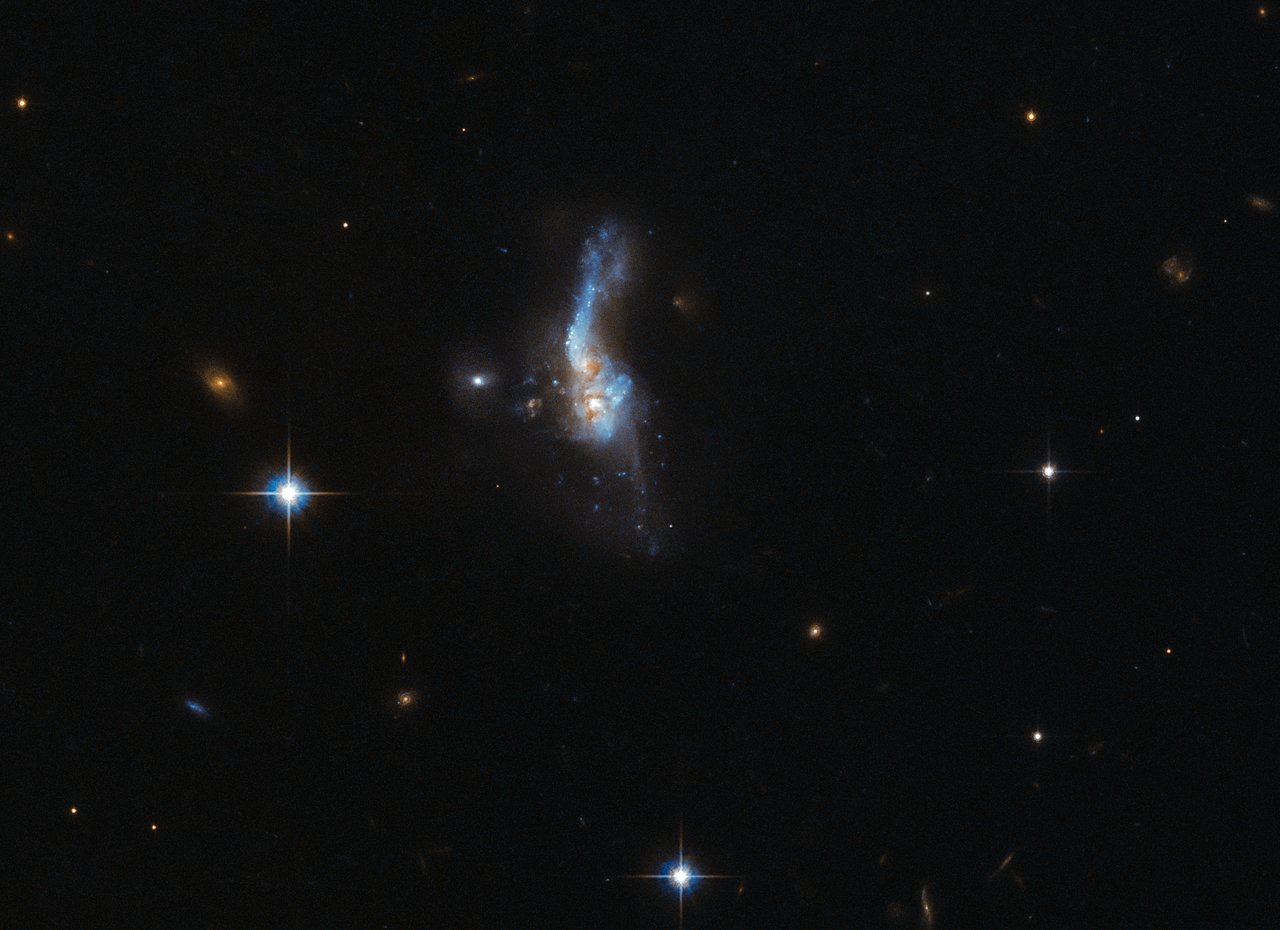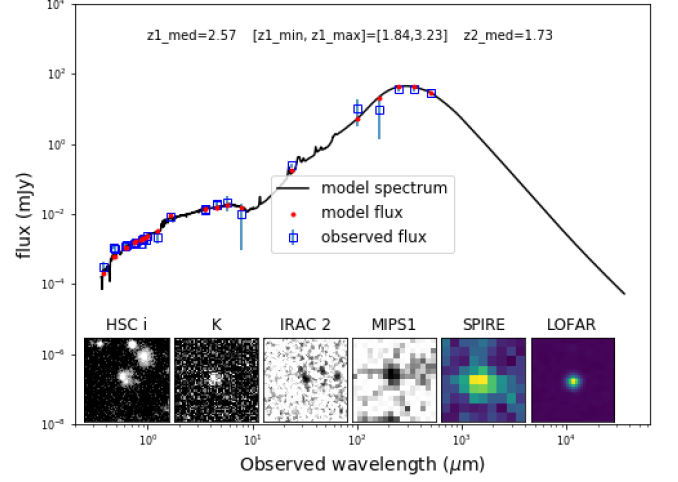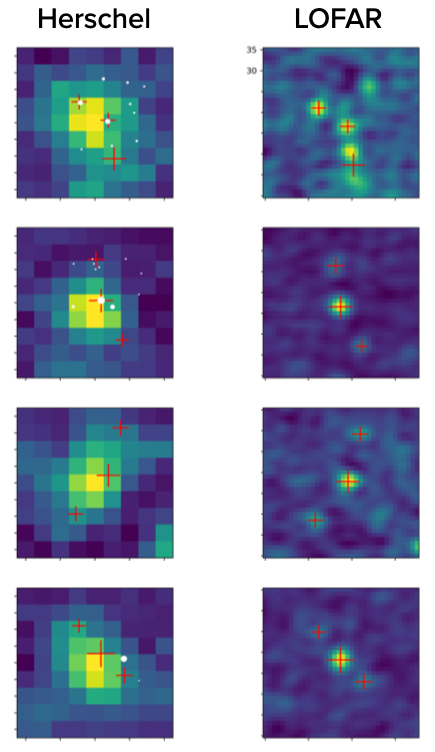(English follows Dutch)
Een team van astronomen onder leiding van SRON heeft tien keer meer hyperlumineuze sterrenstelsels waargenomen in het infrarood dan sterren kunnen produceren volgens theoretische modellen. Als de theorie klopt, kunnen sterren dus niet in hun eentje de helderheid voor hun rekening nemen van de helderste infraroodsterrenstelsels. Publicatie in een speciale editie van Astronomy & Astrophysics. ArXiv-publicatie op 18 november.

Elf miljard jaar geleden—ongeveer drie miljard jaar na de oerknal—begonnen sterrenstelsels zich relatief snel te vormen. Er was gas in overvloed, dus een klein deel van deze vroege sterrenstelsels was in staat om uit te groeien tot zware, hyperlumineuze exemplaren, met een helderheid van tien biljoen zonnen. Terwijl de gasreserves in de loop der tijd opdroogden, konden minder sterrenstelsels op hoge snelheid groeien.
Toen astronomen het heelal bestudeerden met de infrarood-ruimtetelescoop Herschel, zagen ze deze theorie over het algemeen bevestigd. Maar in absolute getallen leek het erop dat er ruim tienmaal teveel hyperlumineuze infraroodsterrenstelsels zijn, zowel in het vroege heelal als dichterbij huis. Helaas kon Herschels ruimtelijke resolutie niet alle individuele sterrenstelsels onderscheiden, zodat ze het niet met zekerheid konden zeggen.
Een internationaal team van astronomen, geleid door Lingyu Wang van SRON en RUG, heeft nu de LOFAR telescoop gebruikt—met een hogere ruimtelijke resolutie—om de sterrenstelsels individueel te onderscheiden. Ze zagen inderdaad meer dan tienmaal zoveel hyperlumineuze sterrenstelsels dan de theorie voorspelt, terwijl ze de onzekerheid terugbrachten tot een factor twee.
‘We onderzoeken nu welke fysische mechanismen zulke extreme sterrenstelsels kunnen aandrijven,’ zegt Wang. ‘Worden ze aangedreven door stervorming of door de aangroei van superzware zwarte gaten? In het eerste geval moeten hyperlumineuze infraroodsterrenstelsels sterren vormen met duizenden zonsmassa’s per jaar. Theoretische modellen kunnen niet genoeg sterrenstelsels produceren die sterren vormen met zulke extreme snelheden. Dus een alternatief scenario is dat ze voornamelijk aangedreven worden door de aangroei rond het superzware zwarte gat in hun centra. We hebben follow-up waarnemingen nodig om de ware aard te bestuderen van deze extreme objecten.’
Het team gaat deze follow-up waarnemingen uitvoeren op het Keck observatorium in Hawaii. Dat geeft ze preciezere data over de roodverschuiving van de sterrenstelsels, en dus hun afstand. Keck heeft een optische telescoop die spectra opneemt. Astronomen leiden de roodverschuiving af uit spectra door te kijken hoeveel golflengtes de karakteristieke vingerafdrukken van stoffen zijn verschoven.


Publicatie
L. Wang, F. Gao, P. N. Best, K. Duncan, M. J. Hardcastle, R. Kondapally, K. Małek, I. McCheyne, J. Sabater, T. Shimwell, C. Tasse, M. Bonato, M. Bondi, R. K. Cochrane, D. Farrah, G. Gürkan, P. Haskell, W. J. Pearson, I. Prandoni, H. J. A. Röttgering, D. J. B. Smith, M. Vaccari, W. L. Williams, ‘The bright-end of the infrared luminosity functions and the abundance of hyperluminous infrared galaxies‘, Astronomy & Astrophysics
Ten times more hyper luminous galaxies observed in the infrared than stars can produce according to models
A team of astronomers led by SRON has observed ten times more hyper luminous galaxies in the infrared than stars can produce according to the models. If the theory is correct, it means that stars alone cannot account for the brightness of the most luminous infrared galaxies. Publication in a special issue of Astronomy & Astrophysics. On ArXiv on November 18th.

After the Universe emerged from the Big Bang 13.8 billion years ago, galaxies filled with stars began to form relatively quickly around three billion years later. There was plenty of gas to go around, so a small portion of these early galaxies were able to grow into massive, hyper luminous galaxies, with a brightness of ten trillion suns. As the gas reserves grew empty with time, fewer galaxies could grow at a fast pace.
When astronomers observed the Universe with the infrared space telescope Herschel, they found that this theory largely checks out. However, in terms of absolute numbers it looked like there are over an order of magnitude too many hyper luminous infrared galaxies, both in the early Universe and more recent epochs. Unfortunately Herschel’s spatial resolution couldn’t resolve all individual galaxies, so they couldn’t say for sure.
An international team of astronomers, led by Lingyu Wang from SRON and RUG, has now used the LOFAR telescope—with higher spatial resolution—to distinguish galaxies individually. They found that indeed there are over an order of magnitude more hyper luminous galaxies than the theory predicts, while bringing the uncertainty down to a factor two.
‘We are now studying what physical mechanisms can power such extreme galaxies,’ says Wang. ‘Are they powered by star formation or by supermassive black hole accretion? If powered by star formation, hyper luminous infrared galaxies would be forming stars at a few thousands solar masses per year. Theoretical models cannot produce that many galaxies forming stars at such extreme rates. So, an alternative scenario is that they are predominantly powered by accretion activity around the central black hole. We need more follow-up observations to study the true nature of these extreme objects.’
The team will perform this follow-up study using the Keck observatory. It will give them more accurate data on galaxies’ redshift and therefore their distance. Keck harbors an optical telescope, providing spectra. Astronomers deduce the redshift from spectra by looking at how many wavelengths the characteristic fingerprints have shifted.


Publication
L. Wang, F. Gao, P. N. Best, K. Duncan, M. J. Hardcastle, R. Kondapally, K. Małek, I. McCheyne, J. Sabater, T. Shimwell, C. Tasse, M. Bonato, M. Bondi, R. K. Cochrane, D. Farrah, G. Gürkan, P. Haskell, W. J. Pearson, I. Prandoni, H. J. A. Röttgering, D. J. B. Smith, M. Vaccari, W. L. Williams, ‘The bright-end of the infrared luminosity functions and the abundance of hyperluminous infrared galaxies‘, Astronomy & Astrophysics


